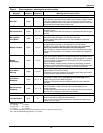
Operation
60
The Liebert Series 610 dynamically adjusts the Battery Shutdown voltage based on battery charac-
teristics and the length of the current discharge event. If a discharge event extends past 15 minutes
(i.e., the load is less than the full design rating), the Battery Shutdown voltage setting is gradually
and automatically increased, to protect the batteries from deep discharge.
When the battery voltage decreases to a preset limit (see 3.2.7 - Alarm Limit Settings Screen), the
Low Battery Warning alarm message appears on the display screen. This warns the operator that the
battery voltage is approaching the Battery Shutdown level—about five minutes of time remaining at
full rated load.
If the battery discharges to the Battery Shutdown level, represented by the lower line on the Battery
Time screen, the battery and input circuit breakers trip open and the UPS module is shut down. This
protects the battery from being damaged by an extended deep discharge.
If the Battery Time screen is displayed while the battery is not discharging, it will display the present
Battery Charge percentage and the results of the previous discharge event.
The Liebert Series 610 records information about each discharge event. This data can be reviewed on
the Battery Cycle Monitor screen, as described in 3.2.5 - Status Reports Screens.
NOTE
The Low Battery alarm setting is designed to be useful at full load battery discharge rates.
Unlike the Battery Shutdown voltage, the Low Battery alarm setting is not automatically
increased and should not be relied upon as an indicator of battery time remaining. Instead, the
operator should consult the Battery Time screen or Present Status screen to see the Calculated
Time Remaining based on actual usage during the discharge period.
!
CAUTION
When battery shutdown occurs, no power will be supplied to the critical load unless power is
available through the bypass line from the utility source (or from an engine generator set). If
you anticipate a battery shutdown (and an engine generator set is not available), either
transfer the load to bypass (if available) or perform a controlled shutdown of the critical load.
NOTE
1. During initial UPS start-up, the Battery Charge will display 100%, even though actual
state of charge may be slightly less. It will normally take three to four days of operation to
completely charge the battery. After the battery is fully charged the first time, Battery
Charge will be an accurate indication of battery status.
2. If Calculated Time Remaining is less than Rated Time Remaining, a battery problem may
be indicated. Battery maintenance personnel should thoroughly examine the battery plant
for factors that may reduce battery performance, such as:
• Battery age
• Excessive battery discharge/recharge cycles
• Bad or weak cells
• Low acid levels in flooded cells
• Loose electrical connections
• Ambient temperature extremes
• Dirty battery jar covers
3. If the battery plant has been thoroughly examined for proper maintenance and condition
and the Calculated value is still less than 80% of Rated value, contact Liebert Global
Services.


















